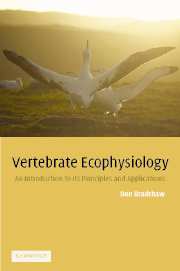Book contents
- Frontmatter
- Contents
- Introduction
- 1 Homeostasis: a fundamental organising paradigm in ecophysiology
- 2 Stress: the concept and the reality
- 3 Basic methods used in ecophysiological studies
- 4 Turnover methodology: theory and practice
- 5 Case studies of stress: incidence and intensity
- 6 Survival in deserts
- 7 Torpor and hibernation in cold climates
- 8 Marine birds and mammals
- 9 Conclusion
- Appendix 1 Population estimation methods
- Appendix 2 Estimation of food intake in Tiliqua rugosa
- Appendix 3 Simultaneous measurement of sodium and potassium concentration in plasma or urine using the IL 143 digital flame photometer
- Appendix 4 Determination of plasma urea nitrogen
- Appendix 5 Radioimmunoassay of testosterone in plasma
- Appendix 6 Preparation of ‘stripped plasma’
- Appendix 7 Radioimmunoassay of testosterone in faeces
- Appendix 8 The comparative method
- Appendix 9 Basic turnover equations
- References
- Index
2 - Stress: the concept and the reality
Published online by Cambridge University Press: 05 June 2012
- Frontmatter
- Contents
- Introduction
- 1 Homeostasis: a fundamental organising paradigm in ecophysiology
- 2 Stress: the concept and the reality
- 3 Basic methods used in ecophysiological studies
- 4 Turnover methodology: theory and practice
- 5 Case studies of stress: incidence and intensity
- 6 Survival in deserts
- 7 Torpor and hibernation in cold climates
- 8 Marine birds and mammals
- 9 Conclusion
- Appendix 1 Population estimation methods
- Appendix 2 Estimation of food intake in Tiliqua rugosa
- Appendix 3 Simultaneous measurement of sodium and potassium concentration in plasma or urine using the IL 143 digital flame photometer
- Appendix 4 Determination of plasma urea nitrogen
- Appendix 5 Radioimmunoassay of testosterone in plasma
- Appendix 6 Preparation of ‘stripped plasma’
- Appendix 7 Radioimmunoassay of testosterone in faeces
- Appendix 8 The comparative method
- Appendix 9 Basic turnover equations
- References
- Index
Summary
We talk very glibly these days of stress, especially the ‘stress of modern-day living’, and in the scientific literature one often finds mention of things such as ‘temperature stress’, ‘water stress’ and ‘the stress of reproduction’. It has proven extraordinarily difficult, however, to agree on a common definition of the term, let alone develop methods for measuring the incidence and intensity of stress in animals.
There is general agreement among biologists that ‘stress’ is an important ecological factor, often contributing to the extinction of rare and endangered species (Bradshaw, 1996, 1999). There are thus a number of important questions that need to be addressed concerning stress, including:
What is stress?
How do we define it and measure its effects?
How does one measure its incidence and severity?
What effects does stress have on an animal's ability to maintain homeostasis?
Does prolonged stress reduce fitness?
Are threatened and endangered species more susceptible to the effects of stress than are other species?
Can we use instances of stress physiology to gauge the level of susceptibility of animal species to environmental change and their likelihood of extinction?
Definitions
It was Walter Cannon again who, as early as 1914, first developed the idea that organisms react to unfavourable situations in terms of highly integrated metabolic activities. Cannon's concept of stress was derived by simple analogy from Newtonian physics where an imposed force (stress) produces a deformation (strain) in an object, with the strain being proportional to the stress.
- Type
- Chapter
- Information
- Vertebrate EcophysiologyAn Introduction to its Principles and Applications, pp. 8 - 14Publisher: Cambridge University PressPrint publication year: 2003



